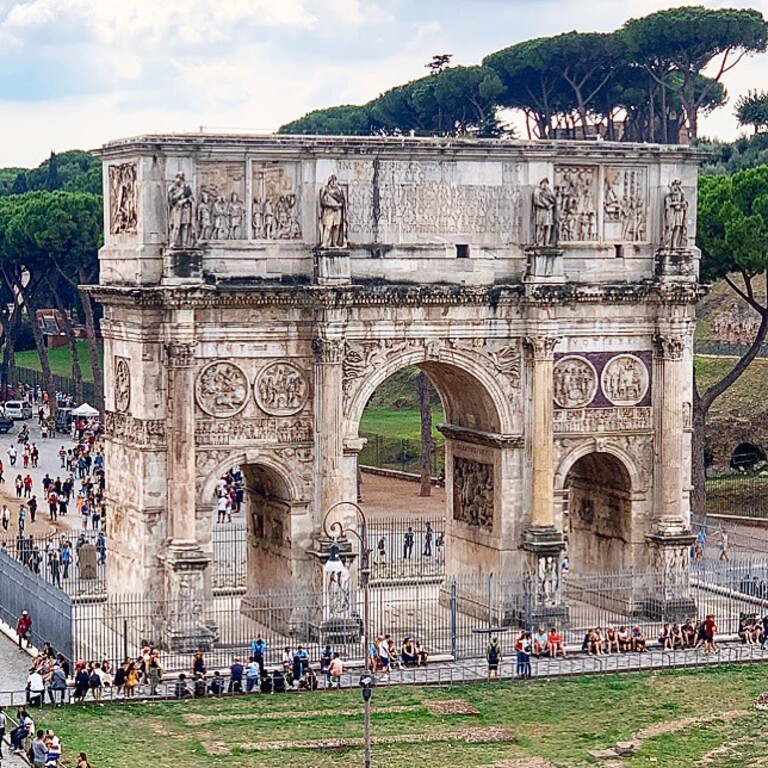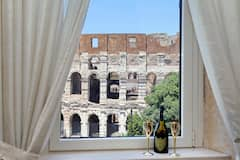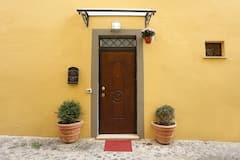The capital of Italy, Rome has been on everyone’s must-visit list because of many beautiful reasons. This place is a mixture of majestic ruins, world-class art scenes, and lively streets full of cafes, restaurants, shops, as well as historical buildings, imposing basilicas, and stunning piazzas. Also, you’ll find here the Vatican City, which a lot of Roman Catholics throughout the world aim to visit once in their lifetime. A week wouldn’t be enough to see everything this commune has to offer, so make sure you plan your itinerary wisely. Check out our list of the best places to visit in Rome, Italy, as your guide to exploring the area.
1. See the ruins of Baths of Caracalla (from USD 183.17)

A public thermae in ancient Rome, Baths of Caracalla, is the second-largest public bath in the city. It is said to be built between 211 to 212 A.D. or 216 to 217 A.D. and operated until the 530s. What you will see when you visit, is the ruins of the former structure, which is a depiction of how developed the Roman Civilization has been. You’ll surely travel back in time when you visit this historic site and learn about its history and stories that revolve around the Baths of Caracalla.
Baths of Caracalla Exclusive Private Guided Tour and Tickets
Duration: 1.5 hour
2. Learn about Emperor Titus at the Arch of Titus

The Arch of Titus is another well-known landmark in Rome that tells about the rich ancient Rome history. It is built to honor Emperor Titus and to commemorate the win of the Romans and the fall of Jerusalem. You can see the victorious procession depicted on the panels located in the arch. There are other inscriptions, symbols, and stories waiting for you when you look at the dome closely, so make sure you take your time viewing the arch when you drop by. If you’re wondering about the contribution or what Titus did in the past to deserve an arc named after him, Emperor Titus is the one who finished the Colosseum and the one who helped the Romans when Mount Vesuvius erupted and during the tragic fire in 80 A.D.
Arch of Titus
Address: Via Sacra, 00186 Roma RM, Italy
Website: Arch of Titus
Opening hours: 24 hours (daily)
Tip from tour guide

While here, make sure to pay attention to this panel on the internal face of the Arch of Titus, which shows the Romans taking artifacts from Herod’s Temple after their victory over the Jewish rebellion in Judea. Also, the menorah depicted on the arch later became the model for the menorah used as the emblem of the state of Israel. Arch you just fascinated by this amazing monument?
3. See the beauty of St. Peter's Square (from USD 27.0)
The most famous and the most beautiful square in the world, St. Peter’s Square is located at the foot of St. Peter’s Basilica. It has an area of 76,800 sq m (826,668.32 sq ft), which can hold up to 300,000 people. One of the highlights of the square is its 284 columns and 88 pillars that borders the plaza in four rows colonnade. Also, you’ll find on the top of the columns are 140 statues of saints by Bernini’s disciples. Other beautiful attractions in St. Peter’s Square are the Egyptian obelisk and two fountains. The obelisk was brought to Rome from Egypt in 1856, while the fountains were created by Bernini and Maderno.
Half-Day Papal Audience in St. Peter's Square with a Guide
Duration: 2 to 3 hours
You might be interested in these Airbnbs!
4. Toss a coin and make a wish at Trevi Fountain (from USD 32.0)
Located in Trevi District, Trevi Fountain is the most famous fountain in the world, and a trip to Rome wouldn’t be complete if you haven’t been photographed here. It is a Baroque-style fountain designed by Nicola Salvi and finished by Giuseppe Pannini and others. The fountain looks magnificent, in the morning, and magical, at night, and the only hindrance that will make it hard for you to take a photo is the many tourists that often flock the area. According to legends, the fountain can grant wishes, and if you throw one coin, you’ll surely come back to Rome; if you drop two coins, you’ll fall in love with a handsome/beautiful Italian; and if you throw three coins, you’ll marry that Italian. Maybe that’s why, aside from the beauty of the fountain, many people go here.
Pantheon, Piazza Navona and, Trevi Fountain Tour of Rome
Duration: 2 hours 30 minutes
Rome Tour Guide
Jamie
A historian and fearless leader, James studied classics at Leeds University in England and has been a tour guide in Rome for more than 13 years. James has a passion for ancient history, concentrating in the late Roman Republic. If you have a spark of interest in anything Roman, James is the best source of information. A dual citizen of Great Britain and Italy, James was born and raised in Rome ... Read more
Tours by Jamie
5. Climb the Spanish Steps (from USD 208.0)
One of the iconic landmarks in Rome, the Spanish steps, is composed of 130 steps that connect Piazza di Spagna at the foot and Piazza Trinita dei Monti at the top. The steps are built in straight flights, curves, vistas, and terraces. You’ll find at the top, in Piazza Trinita dei Monti, the stunning twin tower church by the same name, and many artists that offer to draw portraits of tourists. And at the bottom, you’ll find many shops and restaurants where you can sit and dine or buy souvenirs. Just a warning, if you don’t want to be given a fine, don’t sit on the Spanish Steps.
Rome Small-Group Walking with Pantheon, Trevi, Spanish Steps
Duration: 2 hours
6. Explore Piazza del Popolo
An extensive urban square in Rome, Piazza del Popolo is another famous plaza that is surrounded by many iconic landmarks like the twin Baroque churches of Santa Maria dei Miracoli and Santa Maria in Montesanto. One of the main attractions here is the obelisk that is originally from Egypt, at the Sun Temple in Heliopolis, and it was brought to Rome by Emperor Augustus. Also, you’ll find two fountains, Fontana del Nettuno and Fontana Della dea di Roma, which are odes to Roman gods and goddesses.
Piazza del Popolo
Address: Piazza del Popolo, 00187 Roma RM, Italy
Website: Piazza del Popolo
Opening hours: 24 hours (daily)
7. View the exhibits at Galleria Borghese

Located at the former Villa Borghese Pinciana, Galleria Borghese is a must-see art facility in Rome that features numerous artworks by different artists. You’ll find, in the two floors with 20 rooms, various artworks like sculptures, paintings, frescoes, and more, by renowned artists like Gian Lorenzo Bernini, Pietro Rotari, Caravaggio, Mariano Rossi, and more. Also, located on the grounds, is the Villa Borghese gardens, which was once part of the museum, and now a separate attraction. Make sure to drop by the garden after exploring the museum.
Galleria Borghese
Address: Piazzale Scipione Borghese, 5, 00197 Roma RM, Italy
Website: Galleria Borghese
Opening hours: Tue - Sun: 9am - 7pm; Thu: 9am - 8pm (closed on Mon)
Price: 6 EUR or 6.64 USD
8. Attend a holy mass at the Vatican City (from USD 79.0)
The seat of the Roman Catholic Church, the Vatican City is where you’ll find the home of the pope and a valuable collection of architecture and arts. One of the attractions you’ll find in the country is the Vatican Museum, where many iconic and famous artworks by well-known artists are located. You’ll see here ancient roman sculptures like the “Laocoön and His Sons”, as well as the famous Sistine Chapel’s ceiling created by Michelangelo and the Renaissance frescoes in the Raphael Room. Those mentioned artworks are only a few of the treasures you’ll find in the Vatican City.
Vatican City and Ancient Rome Full-Day Small Group Tour
Duration: 3 hours
9. See the famous fountain at Piazza di Spagna

Located at the foot of the Spanish Steps, Piazza di Spagna is another renowned and most visited square in Rome. It is a perfect example of Italian Baroque design. The name of the piazza was after Palazzo di Spagna, the seat of the Spanish embassy in the Vatican, which was located at the square since the 17th century. Around Piazza di Spagna are striking 17th- and 18th-century villas. And at the center, you’ll find a majestic fountain, Fontana dela Barcaccia, which is shaped like a boat and has the emblem of the Barberini Family. The fountain was started by Pietro Bernini and finished by his son Gian Lorenzo Bernini.
Piazza di Spagna
Address: Piazza di Spagna, 00187 Roma RM, Italy
Website: Piazza di Spagna
Tip from tour guide


The lovely Piazza di Spagna was once known as the English Quarter. Britain's influential artists and writers, including Charles Dickens, Florence Nightingale, Lord Byron, and John Keats, used to reside here. The area is now home to the world's best fashion houses, such as Gucci, Bvlgari, Dior, Prada, Fendi, and more! Also, the charming flight of stairs and the gorgeous views from the top truly elevate the ambiance of this place.
10. Go back in time at the Roman Forum (from USD 63.95)

Another historical site in Rome, the Roman Forum, or in Latin, Forum Romanum, is a plaza that has a rectangular shape, which is located at the center of Rome. What makes it more interesting is the ruins of many significant ancient government structures that surround the plaza. For the dwellers of ancient Rome, this place served as the marketplace, where a lot of important events happened, including elections, famous speeches, gladiatorial fights, and more. Today, it showcases the ruins of the architectural prowess of the former civilization. This historical site attracts over 4.5 million tourists every year.
Rome: Colosseum, Palatine Hill, and Roman Forum Guided Tour
Duration: 3.0 hour
11. Explore the luxurious Quirinal Palace

Located on Quirinal Hill, the highest of the seven hills, Quirinal Palace is one of the homes of the president of the Italian Republic, together with Rome’s Tenuta de Castelporziano and Naples’ Villa Rosebery. It played home to many very important people, including 30 popes, 12 presidents of the Italian Republic, and 4 kings of Italy. Aside from the interior and arts, another exciting thing you’ll see is the ceremony of the changing of guards. It may not be as famous as the one in London but it is still entertaining and an experience like no other.
Quirinal Palace
Address: Piazza del Quirinale, 00187 Roma RM, Italy
Website: Quirinal Palace
Opening hours: Tue, Wed & Fri - Sun: 9:30am - 4pm (closed on Mon & Thu)
12. Be mesmerized by the stunning Archbasilica of St. John Lateran

The oldest church in Europe and the mother church of the Roman Catholic faith, Archbasilica of St. John Lateran, is made in honor of St. John the Baptist and St. John the Evangelist. Every Thursday, you’ll see the pope celebrate the Holy Mass, as the bishop of Rome. Also, it is famous for being the enthronement place of popes up until the year 1870. The basilica has two-stories, and its facade was built during the 18th century. You’ll also see, in the upper part of the facade, the statues of the Apostles of Jesus. If you’re amazed by the beauty of the exterior, wait until you see what’s inside, for it features mosaics, frescoes, huge statues, and impressive columns.
Archbasilica of St. John Lateran
Address: Piazza di S. Giovanni in Laterano, 4, 00184 Roma RM, Italy
Website: Archbasilica of St. John Lateran
13. Admire the striking frescoes of the Sistine Chapel (from USD 36.87)

The Sistine Chapel is famous for being the place where the Roman Catholic leader is chosen. But, apart from its role in the ordaining of a pope, it is also a treasure trove of arts. It is known for its majestic frescoes that tell stories of the Bible, like the creation story, about Noah, the last judgment, and many more. These paintings in the ceiling of the chapel were made by Michelangelo, as ordered by Pope Paul III. It took him over four years to finish. Other famous artists who have artworks here include Perugino, Luca, and Botticelli.
Rome: Vatican Museums, Sistine Chapel Tour and St. Peter's
Duration: 2.5 to 3.0 hour
14. Check out the fascinating Mouth of Truth
Located in Cosmodin Church in Santa Maria, the Mouth of Truth is a legendary sculpture that was dedicated to the god of the sea. The sculpture has holes that serve as his eyes, nose, and mouth. According to legends, this mask is somewhat like an old-fashioned lie detector, for the sculpture caught liars by biting the hand of those that lie. A lot of people go here to be photographed with their hand inside the mouth of the sculpture, so expect a queue if you also want your picture taken here.
Mouth of Truth
Address: Piazza della Bocca della Verità, 18, 00186 Roma RM, Italy
Website: Mouth of Truth
Opening hours: 9:30am - 5:50pm (daily)
Price: 2 EUR or 2.21 USD
Tip from tour guide

The date and the exact purpose of the Mouth of Truth is uncertain. While the marble mask is widely believed to depict an ancient sea god, various theories exist. Some people say that in medieval Rome, it functioned as a lie detector with an executioner standing at the other end with a sharp sword. If he thought that the citizen was lying, he would cut off their hand.
The Mouth of Truth gained cinematic fame in the classic film Roman Holiday, starring Audrey Hepburn in her breakout role.
15. Learn about the Dacian war at the Trajan Column (from USD 407.0)
A column built in honor of Emperor Trajan, Trajan Column is said to have been built in 113 AD after the victory of Emperor Trajan during the Dacian war. The column is 42 meters (138 ft) high. At the top is the statue of St. Peter, and on its base lies the ashes of Trajan and his wife. The marble column also depicts the story of Dacian war campaigns, which you can see in the carved figures.
Rome Capitol to Trajan Column and Roman Forum 3-Hour Tour
Duration: 3 hours
16. Visit the ruins of Pompey Theater at Largo di Torre Argentina

Another beautiful square in Rome, Largo di Torre Argentina, is where you’ll find the four Roman Republican temples and the ruins of Pompey’s Theater. Pompey Theater is famous for it is said to be the place where Caesar was assassinated. Up to this day, you can only view the ruins from the top, and only cats and volunteers are allowed to enter. But there are plans for installing walkways so locals and tourists can finally tour what remains of Pompey Theater.
Largo di Torre Argentina
Address: Largo di Torre Argentina, 00186 Roma RM, Italy
Website: Largo di Torre Argentina
17. Stroll through Via Veneto
Editor's Note: Photo taken from the establishment's official social account
The most affluent street in Rome, Via Veneto is where the celebrities and socialites go to dine, shop, and be seen. It was a popular social hub during the 1950s and 60s, causing the emergence of numerous expensive hotels and vibrant cafes. A few of the famous attractions you will find here include Fontana delle Api by Gian Lorenzo Bernini, the world-renowned Hotel Excelsior, the historic Café Doney, and the restaurant of Girarrosto Fiorentino. You’ll surely experience “La Dolce Vita.”
Via Veneto
Address: Carrer de Ganduxer, 10, 08021 Barcelona, Spain
Website: Via Veneto
Opening hours: Mon - Fri: 1pm - 4pm, 8pm - 11:45pm; Sat: 8pm - 11:45pm (closed on Sun)
18. Learn about the victory of Constantine I at the Arch of Constantine

Set between the Colosseum and Palatine Hill, the Arch of Constantine is another triumphal arc in Rome. It was built to commemorate the win of Constantine I over Maxentius during the Battle of Milvian Bridge. It is 20 meters (66 feet) high and 25 meters (82 feet) wide, with three portals and each bordered by Corinthian columns that are partially engaged. You’ll also see engraved figures that show Constantine I victory and an inscription on marble panel that talks about the greatness of Constantine and how this arch is in honor of his military victory.
Arch of Constantine
Address: Via di San Gregorio, 00186 Roma RM, Italy
Website: Arch of Constantine
19. Cross St. Angelo Bridge and admire the statues of angels
The most beautiful bridge in Rome, St. Angelo Bridge history goes back to the second century AD and the 10 statues of angels that adorned it is only a later addition, during the 17th century. The statues of angels were designed by Gian Lorenzo Bernini, as an order of Pope Clement IX. Now, the bridge has been pedestrianized, and tourists cross here on their way to Castel Sant'Angelo and the Vatican.
St. Angelo Bridge
Address: Ponte Sant'Angelo, 00186 Roma RM, Italy
20. Buy flowers, fruits and vegetables at Campo de' Fiori (from USD 109.0)
Another famous square in Rome, Campo de’ Fiori, which means the field of flowers, is surrounded by important buildings like Palazzo Orsini, which is also frequented by notable people in history. It attracts many people to put up businesses in the location, making it one of the most prosperous areas in Rome. Also, the square has been a place of public execution, and to remember those times, you’ll find here the statue of Giordano Bruno, who was a philosopher, executed in 1600 because of heresy. Now, the park features a Monday to Saturday market that sells flowers, fruits, and vegetables. And in the evening, a lot of people flock here to dine in its restaurants, nightspots, and terraces.
Tip from tour guide

Campo Dei Fiori, located south of Piazza Navona, is a square with a name that directly refers to its medieval past when the area was a meadow of flowers. In 1889, Ettore Ferrari erected a statue of Giordano Bruno to honor him for standing up against the Vatican and consequently being burned alive. As Italy unified, Bruno emerged as a martyr for freedom of thought and the advancement of the sciences.
Rome Food Tour: Trastevere, Campo de' Fiori, and Jewish Ghetto
Duration: 3 hours 30 minutes
21. Marvel at the architecture of Fontana dei Quattro Fiumi
Located in Piazza Navona is another impressive fountain called Fontana dei Quattro Fiumi. It was designed by Gian Lorenzo Bernini, in 1651, for Pope Innocent X, since the Pope’s family palace is located facing the Piazza. The fountain depicts the four river gods representing the four significant rivers in the four continents, which the Roman Catholic has prominent influences, such as the Nile of Africa, Ganges of Asia, the Danube of Europe, and Rio de la Plata of the Americas. And at the top of the four gods is a replica of the Egyptian obelisk subdued by the family emblem, which is a dove carrying an olive twig.
Fontana dei Quattro Fiumi
Address: Piazza Navona, 00186 Roma RM, Italy
Website: Fontana dei Quattro Fiumi
Opening hours: 24 hours (daily)
22. View the opulent chamber of Castel Sant'Angelo (from USD 182.41)

Poised at the bank of Tiber, near the Vatican, Castel Sant'Angelo is a must-visit grand fortress. It was built in the order of Emperor Hadrian, to be used as the family’s mausoleum. But later on, it was used as a military building, then a papal refuge. Today, the castle serves a museum where people can view exhibits, such as splendidly decorated chambers, collections of weapons, and beautifully preserved frescoes of the Renaissance period. Also, on the top floor, you’ll find a terrace where you can see the city from above.
Castel Sant'Angelo | The Tomb of Hadrian Private Guided Tour
Duration: 2.0 hour
23. Stroll through Piazza Navona (from USD 13.01)

A baroque style square in Rome, Piazza Navona, is surrounded by vibrant restaurants and charming terraces, giving the area a lively and fun ambiance. There are also striking buildings that overlook the square, Sant Agnese Church and Palazzo Pamphilj. But the highlights of the piazza are the three stunning fountains built during the term of Pope Gregory XIII, such as Fontana dei Quattro Fiumi by Bernini and Fontana del Nettuno and Fontana del Moro by Giacomo della Porta.
Tip from tour guide

Campo Dei Fiori, located south of Piazza Navona, is a square with a name that directly refers to its medieval past when the area was a meadow of flowers. In 1889, Ettore Ferrari erected a statue of Giordano Bruno to honor him for standing up against the Vatican and consequently being burned alive. As Italy unified, Bruno emerged as a martyr for freedom of thought and the advancement of the sciences.
Rome: Piazza Navona 1-Hour Underground Audio Guide Tour
24. Take your time viewing the exhibits at the Vatican Museums (from USD 41.19)

The fifth-largest museum in the world, with an area of 43,000 sq m (462,848.15 sq ft), the Vatican Museums is a complex of museums featuring numerous artworks collected by popes throughout the centuries, which chronicles the achievement and history of humankind. The collections here include work of renowned Renaissance artists, roman sculptures, striking frescoes, beautiful mosaics, and more. Make sure to take your time viewing and learning about each piece of art.
Rome: Vatican Museums, Sistine Chapel, and Basilica Tour
Duration: 2.5 to 3.0 hour
25. Get an uninterrupted view of Rome at Vittorio Emmanuel II Monument
Dominating Piazza Venezia, Vittorio Emmanuel II Monument is a symbol of a united Italy. It was built in honor of Vittorio Emmanuel II, the first king of the Kingdom of Italy. A lot of ruins and historic churches were destroyed to build this colossal monument. It features Corinthian columns and endless stairs that are carved in marble, and at the top, you’ll find the equestrian sculpture of Victor Emmanuel and goddess Victoria. When you visit, make sure you go up to the panoramic terrace and catch the spectacular view of the city from the top.
Vittorio Emmanuel II Monument
Address: Piazza Venezia, 00186 Roma RM, Italy
Website: Vittorio Emmanuel II Monument
Opening hours: 9am - 7pm (daily)
Price: 7 EUR or 7.75 USD
26. Get a glimpse of ancient Rome at the Colosseum (from USD 23.9)

An oval amphitheater in the center of Rome, the Colosseum started construction in 72 A.D. and was only completed in 80 A.D., which took them almost a decade to complete. The amphitheater is a gift of Emperor Vespasian to his people, which serves as a venue for gladiator fights, the re-enactment of legendary battles, and other spectacles. If you’re wondering why the Colosseum is broken, it is because of natural and human-made disasters like earthquakes and people breaking it and getting the pieces as souvenirs. It is one of the famous attractions in Rome, so make sure you don’t head back home without seeing its grandeur.
Rome: Colosseum, Roman Forum, Palatine Hill Entry Tickets
27. Travel back to ancient Rome at Domus Aurea (from USD 100.0)
Go back in time as you explore the chambers in Nero’s House of Gold and magnificent frescoes, thousand years paintings, and architecture. Domus Aurea was said to be built in 65 to 68 A.D., after the massive fire that happened in ancient Rome. The vast palace has three floors and many chambers showcasing beautiful frescoes and drawings. Up until today, the excavations are still ongoing, hoping to find more historical artifacts. The most recent find is the Sphinx Room, as named by the archaeologists who found it. The vault has frescoes with multi-color decorations, and images of a sphinx, god of Pan, centaurs, and panthers.
Domus Aurea Tour, The Golden House of Nero
Duration: 2 hours
28. Learn about Remus and Romulus at the Palatine Hill (from USD 215.68)

The most famous of the seven hills in Rome, Palatine Hill is said to be the Italian capital’s birthplace and has been inhabited since 1,000 B.C. It is also an opulent neighborhood during the Republican Period, where lots of aristocrats decided to build lavish palaces in this area, whose preserved remains can still be seen up to this day. The famous attractions you’ll see here include the Domus Flavia, House of Livia, House of Augustus, Farnese Gardens, Hippodrome of Domitian, and Palatine Museum.
Palatine Hill and Roman Forum Tour with Fast-Track Entrance
Duration: 2.0 hour
29. Experience touring the Catacombs (from USD 18.8)

This tourist destination in Rome might be unusual and eerie for the Catacombs are located beneath the ground and used as a burial place of Jewish and Christians during the fifth century. You’ll be exploring secret passageways that are dark and damp and see graves that have still names and inscriptions on it. Another thing you’ll notice is there are a lot of small graves beside bigger ones, which is because of the high infant mortality rate during that time.
Catacombs & St John in Lateran Combo Tour
Duration: 1 hour
30. Take a tour of Circus Maximus (from USD 42.0)
A chariot racetrack during ancient Rome, Circus Maximus, like the Colosseum, was taken apart because of its precious marbles. It also holds gladiator fights, Roman games, and other events of importance. It is also said to be the largest and oldest stadium in ancient Rome. Now, you can tour what remains of this grand event venue and get a glimpse of what it has been, when you join guided tours. Listen intently to your guide to know more about its history.
Circus Maximus Caracalla Bath and Aventine Hill Tour in Rome
Duration: 3 hours
Explore the historical city
Make the best of your time in Rome by exploring every nook and corner of the city. Here, you’ll have no choice but to learn more about the history of the Roman Empire as you visit the many ruins, historical sites, and beautiful churches. Also, don’t forget to have a chill time to experience dolce la vita, as the Italians say it. As a guide, read on our list of the best places to visit while in Rome, Italy.
History
Get Trip101 in your inbox
Unsubscribe in one click. See our Privacy Policy for more information on how we use your data
























.jpg)












































Create an account to